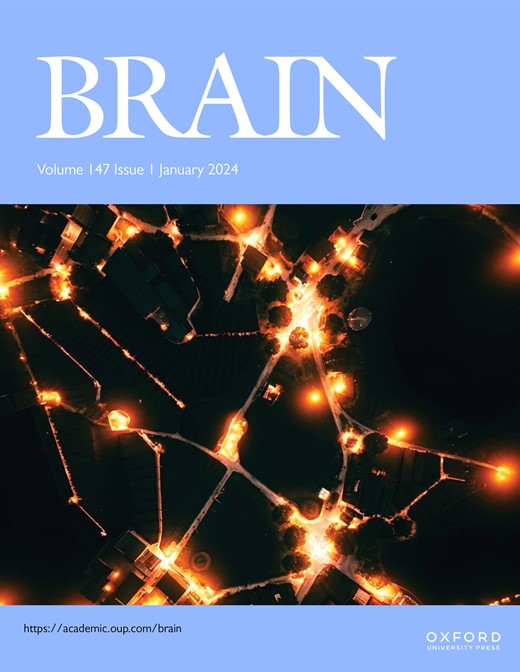神经退行性和神经炎性脑疾病的结构协方差分析。
IF 10.6
1区 医学
Q1 CLINICAL NEUROLOGY
引用次数: 0
摘要
结构MRI可以有效评估与神经系统疾病和衰老相关的脑组织改变。传统的形态学MRI指标,如皮质体积和厚度,在个体水平上仅部分与功能损伤和疾病轨迹相关。新兴研究越来越关注通过分析共变形态模式来重建大脑区域间的中观和宏观结构关系。这些模式表明,特定大脑区域的结构变化倾向于与个体之间其他区域的偏差协变,这种现象被称为结构协方差。这一概念反映了生理和病理过程遵循解剖学定义的扩散模式的观点。先进的计算策略,特别是那些在图形理论框架内的计算策略,在全脑和区域水平上产生可量化的属性,与经典的萎缩模式相比,它们与临床状态或认知表现的关系更密切。这篇综述强调了在个体基础上评估形态计量协方差网络的前沿方法,重点是它们在表征衰老、中枢神经系统炎症和神经变性方面的应用。具体来说,这些方法在量化阿尔茨海默病、帕金森病、额颞叶痴呆和多发性硬化症患者的结构改变方面具有重要的潜力。通过捕获每个个体大脑的独特形态计量学组织,结构协方差网络分析允许跟踪和预测病理进展和临床结果,这些信息可以集成到临床决策中,并在临床试验中用作变量。此外,通过研究结构协方差的不同和交叉诊断模式,这些方法提供了对理解严重神经系统疾病及其治疗意义至关重要的共享机制过程的见解。这些进步为更精确的诊断工具和有针对性的治疗策略铺平了道路。本文章由计算机程序翻译,如有差异,请以英文原文为准。
Structural covariance analysis for neurodegenerative and neuroinflammatory brain disorders.
Structural MRI can robustly assess brain tissue alterations related to neurological diseases and ageing. Traditional morphological MRI metrics, such as cortical volume and thickness, only partially relate to functional impairment and disease trajectories at the individual level. Emerging research has increasingly focused on reconstructing interregional meso- and macro-structural relationships in the brain by analysing covarying morphometric patterns. These patterns suggest that structural variations in specific brain regions tend to covary with deviations in other regions across individuals, a phenomenon termed structural covariance. This concept reflects the idea that physiological and pathological processes follow an anatomically defined spreading pattern. Advanced computational strategies, particularly those within the graph-theoretical framework, yield quantifiable properties at both the whole-brain and regional levels, which correlate more closely with the clinical state or cognitive performance than classical atrophy patterns. This review highlights cutting-edge methods for evaluating morphometric covariance networks on an individual basis, with a focus on their utility in characterizing ageing, central nervous system inflammation and neurodegeneration. Specifically, these methods hold significant potential for quantifying structural alterations in patients with Alzheimer's disease, Parkinson's disease, frontotemporal dementia, and multiple sclerosis. By capturing the distinctive morphometric organization of each individual's brain, structural covariance network analyses allow for the tracking and prediction of pathology progression and clinically outcomes, information that can be integrated into clinical decision-making and used as variables in clinical trials. Furthermore, by investigating distinct and cross-diagnostic patterns of structural covariance, these approaches offer insights into shared mechanistic processes that are critical to the understanding of severe neurological disorders and their therapeutic implications. Such advancements pave the way for more precise diagnostic tools and targeted therapeutic strategies.
求助全文
通过发布文献求助,成功后即可免费获取论文全文。
去求助
来源期刊

Brain
医学-临床神经学
CiteScore
20.30
自引率
4.10%
发文量
458
审稿时长
3-6 weeks
期刊介绍:
Brain, a journal focused on clinical neurology and translational neuroscience, has been publishing landmark papers since 1878. The journal aims to expand its scope by including studies that shed light on disease mechanisms and conducting innovative clinical trials for brain disorders. With a wide range of topics covered, the Editorial Board represents the international readership and diverse coverage of the journal. Accepted articles are promptly posted online, typically within a few weeks of acceptance. As of 2022, Brain holds an impressive impact factor of 14.5, according to the Journal Citation Reports.
 求助内容:
求助内容: 应助结果提醒方式:
应助结果提醒方式:


